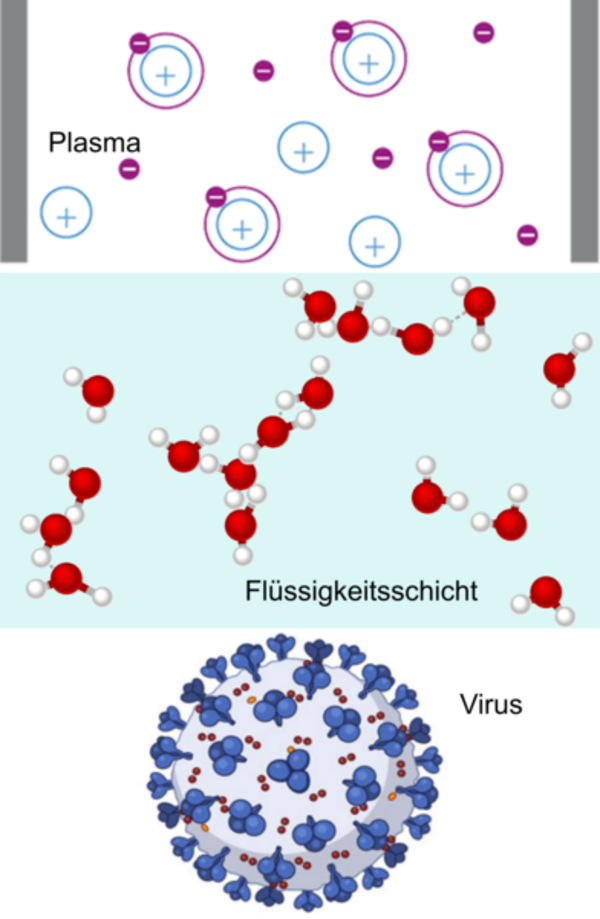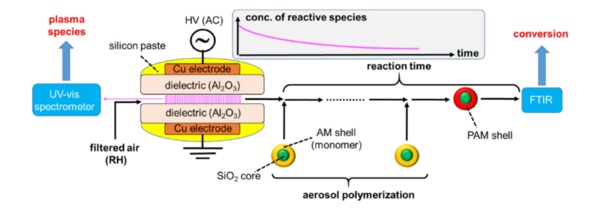Fundamentals of plasma disinfection for inactivation of viruses in aerosol particles: Influence of liquid films
Fundamentals of plasma disinfection for inactivation of viruses in aerosol particles: Influence of liquid films
Plasma is often defined as the 4th state of matter in addition to the three commonly known states of matter (solid, liquid, gas). It is created by heating matter, usually to 100,000 degrees or more. The sun is a typical example here. However, one can also create cold plasma where the gas is only partially ionized. That is, here just enough energy is added to the gas so that although the electrons are set in motion and thus become hot, only a few particles are ionized. The electrons here can be many thousands of degrees hot without raising the temperature of the entire plasma to more than room temperature.
Cold plasmas such as dielectric barrier discharge (DBD) are used to selectively inactivate and eliminate microorganisms. They are used to eliminate toxic or unwanted pollutants in indoor air or exhaust streams and are even used to target and destroy cancer cells. This is accomplished without harming the environment or producing pollutants. Consequently, plasmas are particularly suitable for sterilizing medical instruments, textiles, food and even the skin or wounds.
Inactivation of viruses in aerosol particles has gained importance due to the Covid 19 pandemic. One idea is to filter the particles and then use cold plasma to eliminate the viruses. An alternative approach is to inactivate the viruses directly in the aerosol state. However, in liquid aerosol particles, the viruses are surrounded by moisture layers and the interaction between the plasma species and the liquid layer is poorly understood. Atomistic simulations can provide fundamental insights into plasma disinfection processes that are difficult or impossible to access through experiments. In this project, molecular dynamics simulations will be performed to investigate the interaction mechanisms of reactive plasma species with liquid films surrounding the viruses. The plasma membrane of the virus is modeled as a lipid bilayer. The behavior of reactive species in a liquid film will be studied to determine if these species can penetrate this layer and reach biomolecules. The concentration of active species at the plasma source and their decay over time will be determined directly from experiments using UV-vis spectroscopy of the DBD plasma and a radical-sensitive tracer reaction.

The project "Fundamentals of plasma disinfection for the inactivation of viruses in aerosol particles: Influence of liquid films" was initially funded by the DFG for a period of 12 months. Based on the very good results of the project, a follow-up funding for 3 years was granted in 2023 under the title "Deactivation potential of cold athmospheric plasma for viruses and bacteria". Jun.-Prof. Dr. Nina Merkert (SWZ, TU Clausthal) and Prof. Dr. Alfred Weber (Institute for Mechanical Process Engineering, TU Clausthal) are involved in the project.
Publication list
- M. Shaban, N. Merkert, A. C. T. van Duin, D. van Duin, A. P. Weber. Advancing DBD Plasma Chemistry: Insights into reactive nitrogen species (RNS) such as NO2, N2O5, and N2O Optimization and Species Reactivity through Experiments and Molecular Dynamics Simulations. Environ. Sci. Technol. 58(36): 16087, DOI: 10.1021/acs.est.4c04894, 2024
